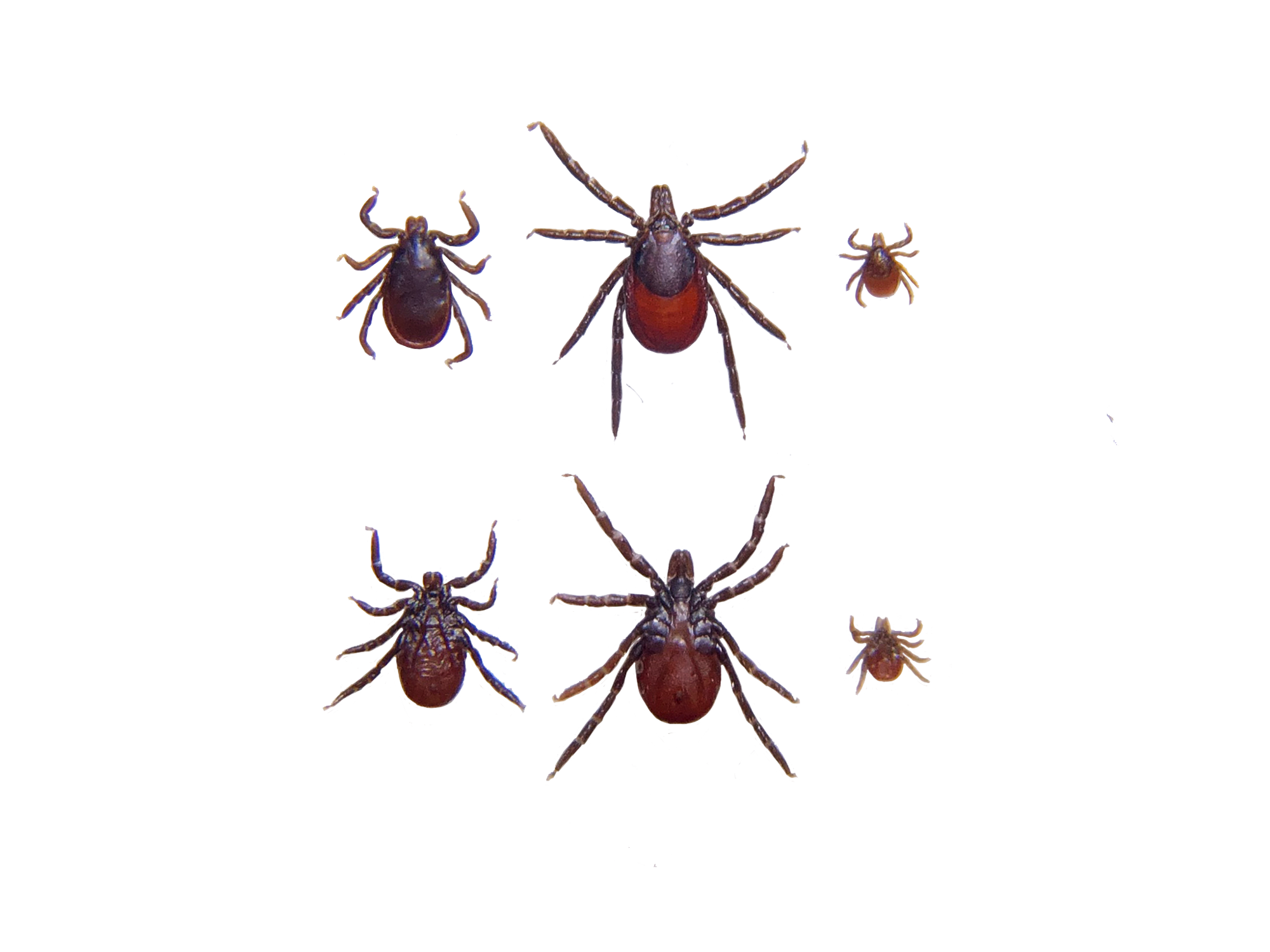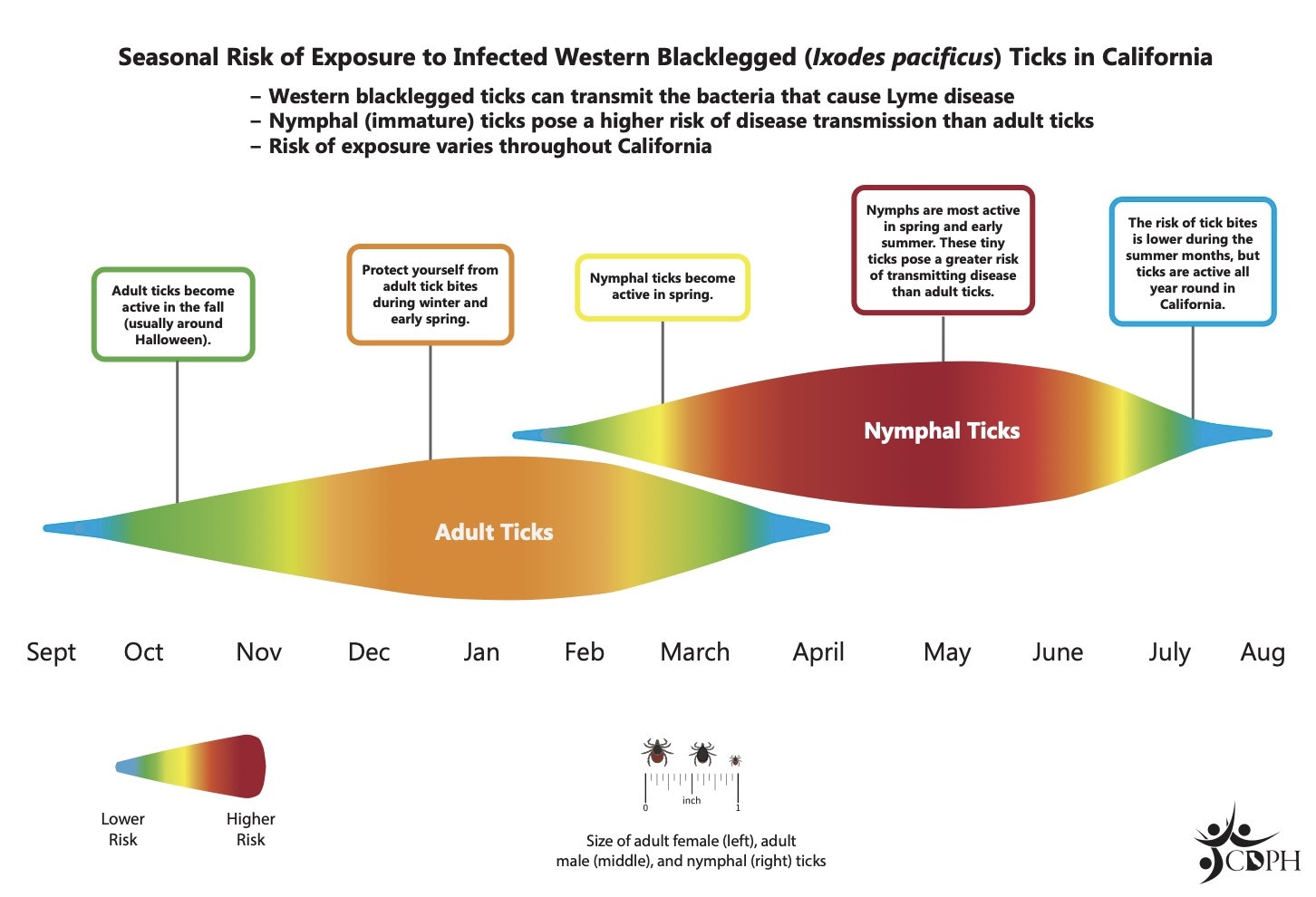Lyme Disease
What is Lyme disease?
Lyme disease is caused by a bacteria (Borrelia burgdorferi) which is transmitted by ticks. It may be cured by early diagnosis and appropriate antibiotic treatment, but it may persist in the human body for years, if not properly treated. Lyme disease was named for Old Lyme, Connecticut, where the first cases of Lyme disease were reported. The first case in California was reported in 1978. It is currently the most commonly reported tick-borne disease in California, as well as in the United States.
Statistics on Lyme disease infections in the US can be found on the CDC website.
Is the tick that transmits Lyme disease in San Mateo County?
Yes, the most commonly encountered tick in San Mateo County during winter and spring is the western black-legged tick (Ixodes pacificus), a known vector of Lyme disease. Lyme disease bacteria have been detected in approximately 3% or less of western black-legged ticks in San Mateo County. Infected ticks have been found along recreational trails throughout the County.
How do people get Lyme disease?
People become infected when they are fed on by infected ticks. Adult ticks are commonly encountered when people’s clothing brushes over grass or bushes along the edges of hiking trails. Nymphal ticks occur on fallen logs and leaf litter in wooded areas. People can pick them up on their clothes or skin when leaning against trees, sitting on logs, or playing in fallen leaves. Nymphs are particularly dangerous because their small size allows them to go undetected, and they may feed on a person for several days without being found.
If I am bitten by a tick, will I get Lyme disease?
Not necessarily. First, not every tick carries the infection. Second, laboratory evidence indicates that the bacterium is usually not transmitted to humans until the tick has fed for at least 24-48 hours. The best defense against Lyme disease is to check for ticks after hiking and to remove ticks as soon as possible after they attach.
What are the symptoms and signs of Lyme disease?
An early sign of Lyme disease infection often includes a spreading “bulls-eye” rash which may be accompanied by fever, aches, and/or fatigue. Symptoms that occur during the later stages of the disease can include complications of the heart and/or nervous system, as well as severe arthritis. Lyme disease presents itself with a variety of symptoms and signs in different people. If infected, you may experience one, both, or none of these symptoms/stages and they could overlap.
Early Symptoms
The first recognizable sign is usually a slowly enlarging red rash, known as erythema migrans (EM), about the size of a half-dollar or larger. This is noticed in 60–80% of persons who contract Lyme disease, although some patients never get a rash. One or more rashes may appear on the body. The rash occurs 3–30 days (average 7–9 days) after the bite of an infected tick. The rash expands over a period of days or weeks to form a large circular lesion, often with a central clearing.
Flu-like symptoms may also occur in this stage. These symptoms may persist, change, disappear, and reappear intermittently for several weeks.
Often, a tick bite will be followed by a reaction within hours creating a redness at the site of the bite which does not expand and disappears within a couple of days. This is not the same as the spreading EM rash characteristic of Lyme disease.
Later Symptoms
If Lyme disease goes untreated, patients may experience migratory pain in joints, tendons, muscles, and bones often without joint swelling or redness; however, months after onset, arthritis with marked joint swelling is common. Some infected persons may develop long-term complications weeks to months after the initial symptoms. These complications may include disorders of the heart or nervous system. Abnormalities of the heart include various degrees of heart block (disturbance of the electrical conduction system), facial paralysis (Bell’s palsy), and other nervous system abnormalities may occur.
Is Lyme disease treatable?
Yes. Most cases of Lyme disease can be successfully treated with antibiotics, but early treatment is important.
Some people may continue to experience symptoms even after they have been treated for Lyme disease. This is called ‘post-treatment Lyme disease syndrome’. Researchers believe it may be the result of residual damage to the body caused during the infection.
Are blood tests accurate in detecting Lyme disease?
The CDC recommends a two-step process when testing blood for antibodies to the bacteria that cause Lyme disease.
What does a tick look like?

In California, the western black-legged tick is the primary carrier of Lyme disease. The adult female is reddish-brown with black legs, about 1/8 of an inch long; males are smaller and entirely brownish black. Ticks that have taken a blood meal (called engorged) will appear much larger, gray in color, and can reach the size of a pea. Ticks in their immature life stages can be as small as the head of a pin or poppy seed.
Where is the western black-legged tick found?
This tick can be found on grasses and brush at the edges of trails and along ecotones (where grass lands and brush meet). Adult ticks feed on deer, rabbits, lizards, mice, and other animals. Ticks do not fly, jump, or drop from trees. They climb to the tips of vegetation, typically along animal trails or paths, and wait for an animal or human host to brush against them so they can attach themselves. These ticks have been found throughout San Mateo County. The District conducts routine surveys for tick densities and infection rate.
Is Lyme disease only a summertime threat?
The different stages of the western blacklegged tick feed at different times of the year, but are most abundant in winter and spring. The adult ticks are usually seen November through April. The nymphal tick (an immature stage) is usually present early spring to late summer, peaking in mid to late May. Due to the small size of the nymphs, the chances of having an unnoticed attached tick are increased.

Can pets get Lyme disease?

Yes. Lyme disease has been reported in dogs, rarely in cats, horses, as well as a number of wild animals. Symptoms may include fever, loss of appetite, arthritis, intermittent paralysis, and lack of energy (no rash). The products used for fleas will also control ticks. Check for ticks and brush your pet after exposure to ticks. Have your pet examined by a veterinarian if you suspect it has Lyme disease.
Where can I get more information about Lyme disease?
Visit the California Department of Public Health website to learn more about Lyme Disease.
Visit the CDC website to learn more about Lyme Disease.
Page last reviewed: May 2, 2025
